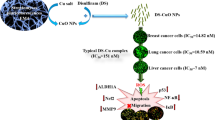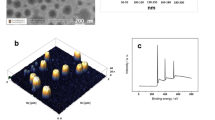Abstract
Ascorbic acid has been previously discussed to have antitumor potential through its interaction with transition metal ions such as iron and copper. Furthermore, ascorbic acid may act as a reducing agent for Ru(III) compounds such as indazolium trans-[tetrachlorobis(1H-indazole)ruthenate(III)] (KP1019), an investigational anticancer drug which is supposed to be activated by reduction, prior to binding to cellular target proteins. Therefore, we investigated the influence of ascorbic acid on the activity of this antitumor metal complex in cell culture studies. We show that co-incubation of equicytotoxic, constant amounts of KP1019 with high concentrations of ascorbic acid (50–700 μM) increases cytotoxicity of the ruthenium anticancer drug in the human colon carcinoma cell line SW480, human cervical carcinoma KB-3-1 cells, and the multidrug-resistant subline KBC-1, whereas addition of low concentrations (2.7–50 μM) has a strong chemoprotective effect in the human colon carcinoma cell line SW480, but not in multidrug-resistant KBC-1 cells. Although cellular uptake of KP1019 is not altered, ascorbic acid induce stronger interaction of the ruthenium compound with DNA both in SW480 cells and under cell-free conditions with plasmid DNA. Even if DNA interactions probably play a subordinate role in vivo given the extensive protein binding of the compound, our data exemplify that ascorbic acid enhances the reactivity of KP1019 with biomolecules. Moreover, we demonstrate that the levels of KP1019-generated reactive oxygen species are markedly decreased by co-incubation with ascorbic acid. Conclusively, our results indicate that application of high doses of ascorbic acid might increase the anticancer effects of KP1019.







Similar content being viewed by others
Abbreviations
- DCFH-DA:
-
2′,7′-Dichlorodihydrofluorescein diacetate
- D-PBS:
-
Dulbecco’s phosphate-buffered saline
- ICP-MS:
-
Inductively coupled plasma mass spectrometry
- KP1019:
-
Indazolium trans-[tetrachlorobis-(1H-indazole)ruthenate(III)]
- MEM:
-
Eagle’s minimum essential medium
- MTT:
-
3-(4,5-Dimethyl-2-thiazolyl)-2,5-diphenyl-2H-tetrazolium bromide
- NAMI-A:
-
Imidazolium trans-[tetrachloro(dimethyl sulfoxide)(1H-imidazole)ruthenate(III)]
- P-gp:
-
P-glycoprotein
- RNS:
-
Reactive nitrogen species
- ROS:
-
Reactive oxygen species
- TBS:
-
Tris(hydroxymethyl)aminomethane-buffered saline
- Tris:
-
Tris(hydroxymethyl)aminomethane
References
Clarke MJ (2003) Coord Chem Rev 236:209–233
Alessio E, Mestroni G, Bergamo A, Sava G (2004) Curr Topics Med Chem 4:1525–1535
Sava G, Zorzet S, Turrin C, Vita F, Soranzo M, Zabucchi G, Cocchietto M, Bergamo A, DiGiovine S, Pezzoni G, Sartor L, Garbisa S (2003) Clin Cancer Res 9:1898–1905
Hartinger CG, Zorbas-Seifried S, Jakupec MA, Kynast B, Zorbas H, Keppler BK (2006) J Inorg Biochem 100:891–904
Galanski M, Arion VB, Jakupec MA, Keppler BK (2003) Curr Pharm Des 9:2078–2089
Jungwirth U, Kowol CR, Keppler BK, Hartinger CG, Berger W, Heffeter P (2011) Antioxid Redox Signal. doi:10.1089/ars.2010.3663
Arrigoni O, De Tullio MC (2002) Biochim Biophys Acta 1569:1–9
Reisner E, Arion VB, Guedes da Silva MFC, Lichtenecker R, Eichinger A, Keppler BK, Kukushkin VY, Pombeiro AJL (2004) Inorg Chem 43:7083–7093
Kapitza S, Pongratz M, Jakupec MA, Heffeter P, Berger W, Lackinger L, Keppler BK, Marian B (2005) J Cancer Res Clin Oncol 131:101–110
Kapitza S, Jakupec MA, Uhl M, Keppler BK, Marian B (2005) Cancer Lett 226:115–121
Brabec V, Novakova O (2006) Drug Resist Updat 9:111–122
Gopal YNV, Kondapi AK (2001) J Biosci 26:271–276
Chen Q, Espey MG, Krishna MC, Mitchell JB, Corpe CP, Buettner GR, Shacter E, Levine M (2005) Proc Natl Acad Sci USA 102:13604–13609
Chen Q, Espey MG, Sun AY, Lee J-H, Krishna MC, Shacter E, Choyke PL, Pooput C, Kirk KL, Buettner GR, Levine M (2007) Proc Natl Acad Sci USA 104:8749–8754
Chen Q, Espey MG, Sun AY, Pooput C, Kirk KL, Krishna MC, Khosh DB, Drisko J, Leven M (2008) Proc Natl Acad Sci USA 105:11105–11109
Oberley TD, Oberley LW (1997) Histol Histopathol 12:525–535
Hoffer LJ, Levine M, Assouline S, Melnychuk D, Padayatty SJ, Rosadiuk K, Rousseau C, Robitaille L, Miller WH Jr (2008) Ann Oncol 19:1969–1974
Moertel CG, Fleming TR, Creagan ET, Rubin J, O’Connell MJ, Ames MM (1985) N Engl J Med 312:137–141. doi:10.1056/nejm198501173120301
Levine M, Conry-Cantilena C, Wang Y, Welch RW, Washiko PW, Dhariwal KR, Park JB, Lazarev A, Graumlich JF et al (1996) Proc Natl Acad Sci USA 93:3704–3709
Riordan NH, Riordan HD, Meng X, Li Y, Jackson JA (1995) Med Hypotheses 44:207–213
Frei B, Lawson S (2008) Proc Natl Acad Sci USA 105:11037–11038
Ohno S, Ohno Y, Suzuki N, Soma G-I, Inoue M (2009) Anticancer Res 29:809–815
Heaney ML, Gardner JR, Karasavvas N, Golde DW, Scheinberg DA, Smith EA, O’Connor OA (2008) Cancer Res 68:8031–8038
Schluga P, Hartinger CG, Egger A, Reisner E, Galanski M, Jakupec MA, Keppler BK (2006) Dalton Trans 1796–1802
Lipponer K-G, Vogel E, Keppler BK (1996) Metal Based Drugs 3:243–260
Halliwell B, Whiteman M (2004) Br J Pharmacol 142:231–255
Egger AE, Rappel C, Jakupec MA, Hartinger CG, Heffeter P, Keppler BK (2009) J Anal At Spectrom 24:51–61
Zorbas-Seifried S, Jakupec MA, Kukushkin NV, Groessl M, Hartinger CG, Semenova O, Zorbas H, Kukushkin VY, Keppler BK (2007) Mol Pharmacol 71:357–365
Satoh K, Ida Y, Hosaka M, Arakawa H, Maeda M, Ishihara M, Kunii S, Kanda Y, Toguchi M, Sakagami H (1998) Anticancer Res 18:4371–4375
Sakagami H, Satoh K, Fukuchi K, Gomi K, Takeda M (1997) Free Radic Biol Med 23:260–270. doi: S0891584996006211
Sakagami H, Satoh K, Hakeda Y, Kumegawa M (2000) Cell Mol Biol (Noisy-le-grand) 46:129–143
Amano Y, Sakagami H, Tanaka T, Yamanaka Y, Nishimoto Y, Yamaguchi M, Takeda M (1998) Anticancer Res 18:2503–2506
Carr A, Frei B (1999) FASEB J 13:1007–1024
Frei B, England L, Ames BN (1989) Proc Natl Acad Sci USA 86:6377–6381
Bevan RJ, Mistry N, Patel PR, Halligan EP, Dove R, Lunec J (2010) Br J Nutrit 103:686–695. doi:10.1017/S0007114509992285
Sava G, Bergamo A, Zorzet S, Gava B, Casarsa C, Cocchietto M, Furlani A, Scarcia V, Serli B, Iengo E, Alessio E, Mestroni G (2002) Eur J Cancer 38:427–435
Heffeter P, Pongratz M, Steiner E, Chiba P, Jakupec MA, Elbling L, Marian B, Koerner W, Sevelda F, Micksche M, Keppler BK, Berger W (2005) J Pharmacol Exp Ther 312:281–289
Timerbaev AR, Foteeva LS, Rudnev AV, Abramski JK, Polec-Pawlak K, Hartinger CG, Jarosz M, Keppler BK (2007) Electrophoresis 28:2235–2240
Piccioli F, Sabatini S, Messori L, Orioli P, Hartinger CG, Keppler BK (2004) J Inorg Biochem 98:1135–1142
Cetinbas N, Webb MI, Dubland JA, Walsby CJ (2010) J Biol Inorg Chem 15:131–145
Langemann H, Torhorst J, Kabiersch A, Krenger W, Honegger CG (1989) Int J Cancer 43:1169–1173
Agus DB, Vera JC, Golde DW (1999) Cancer Res 59:4555–4558
Heffeter P, Boeck K, Atil B, Hoda MAR, Koerner W, Bartel C, Jungwirth U, Keppler BK, Micksche M, Berger W, Koellensperger G (2010) J Biol Inorg Chem 15:737–748
Acknowledgments
The authors acknowledge Daniel Schachner (Department of Pharmacognosy, University of Vienna) for performing fluorescence-activated cell sorting analyses. This work was supported by the Austrian Research Promotion Agency (FFG), project no. 811591 (B.K.), and the Fellinger Krebsforschungsverein (P.H.).
Author information
Authors and Affiliations
Corresponding author
Additional information
C. Bartel and A.E. Egger contributed equally to this work.
Electronic supplementary material
Below is the link to the electronic supplementary material.
Rights and permissions
About this article
Cite this article
Bartel, C., Egger, A.E., Jakupec, M.A. et al. Influence of ascorbic acid on the activity of the investigational anticancer drug KP1019. J Biol Inorg Chem 16, 1205–1215 (2011). https://doi.org/10.1007/s00775-011-0809-4
Received:
Accepted:
Published:
Issue Date:
DOI: https://doi.org/10.1007/s00775-011-0809-4




